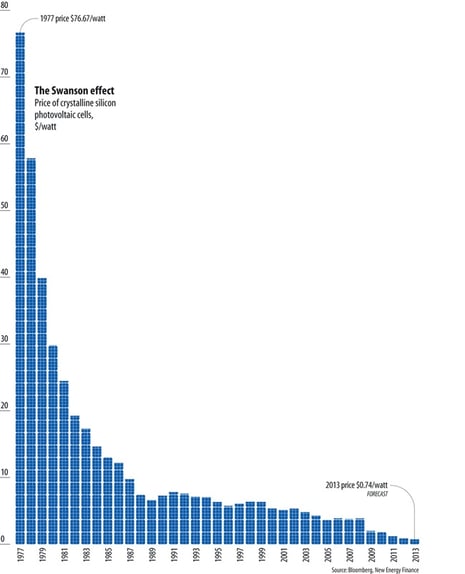Publish Date: January 11th, 2018
Before we start, can we take a minute to appreciate how cool solar technology is? It all starts in the sun’s core where nuclear fusion releases both heat and light. This heat and light radiates out to our little blue and green planet almost 93 million miles away, and once those rays get here, we’ve created solar panels to capture energy from the sun’s rays and transform it into the electricity that we use to power our modern lives. That is absolutely remarkable and inspiring to think about!
Solar panels are the heart of any solar energy system, so this post will cover the average cost of solar panels while also helping you learn more about the differences between solar panels. You can also learn more about how solar panels work if you want to know the science behind the remarkable technology that captures energy from the sun.
Average Cost of Solar Panels Over Time
Did you know that the first solar cell able to convert sunlight into electricity was invented in 1838? The initial technology didn’t take off, but that didn’t stop others from continuing to explore ways to capture solar energy. The first solar cell capable of powering everyday electrical equipment was born in 1954 at Bell Telephone Laboratories, and from there the technology has been developing and improving at an impressive rate. (Learn more about the history of solar.)
As innovation has continued, the average cost of solar panels has dropped dramatically. In 1977, during the early days of solar technology, solar cost a whopping $77 per watt. Solar modules can now cost as little as $0.35 per watt for some of the lower-quality modules. Today the price of solar panels has become fairly stable, though new developments continue to improve on the technology and its efficiency.

Differences Between Solar Panels
Solar cells are the basic unit of solar technology. Multiple solar cells are connected together to make one solar module or panel. The basic way that solar cells gather sunlight into electricity is the same for every panel, but there are differences in manufacturing that create differences between solar panels.
When it comes to the solar cells themselves, the two most common types are monocrystalline and polycrystalline. The differences between these two solar cells stems from the manufacturing process and how the silicone they’re made of is melted and then reformed. When manufacturing monocrystalline solar panels, silicon is melted and reformed into single crystal cylinders. These cylinders are then cut into square wafers to be used for the solar cells. The process is more expensive and wastes some silicon, but it results in higher efficiency panels because of the higher purity of the silicon crystal.
When manufacturing polycrystalline solar panels, silicon is melted, poured into a square mold, and allowed to cool. Multiple crystals form as the silicon cools within the mold, and the square mold can then be cut into neat, square wafers for the solar cells. This process is less expensive and reduces silicon waste, but the result is a less efficient panel because of the lower purity of the silicon crystals.
A handful of other technologies, like thin film solar cells or clear solar cells, are in development. These technologies are not yet competitive, but as time goes on, innovation and new discoveries will surely bring new advances to the solar industry. Wondering if you should wait for the next big discovery? It’s tempting, but you might be waiting and waiting until you’ve already missed out on the solar savings you could have accumulated by investing now. The technology available today is already a great investment that will pay for itself over time and save you money in the end.
Choosing Your Solar Panels
So how do you know which solar panels will the best choice for your home solar installation? Do you pay more for higher efficiency panels or do you go with more economical panels for your array? In the end, it’s more about the design of your solar array system than it is about the specific efficiency of your solar panels. Namaste Solar only works with high-quality panels so you won’t have to choose between bad, good, or great panels. Instead, we focus on your customized design and providing the best system for your home that will maximize your return on investment. (Learn more about the cost to go solar to better understand what factors play into the final system price.)
For example, a home with plenty of usable roof space can use less efficient, though still high-quality, panels to save on cost and increase ROI potential. A home with less usable roof space or aesthetic concerns may use higher efficiency panels to achieve the same energy production potential with a smaller system. The panels may be the star of the show, but a well-designed solar panel system that is customized to your home and your needs is where the real magic happens.
Get expert, honest answers to the top questions you need to ask when considering solar for your home.
Do you want to see how much you could save by going solar?
Contact our team of solar experts to request a free quote.


